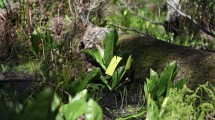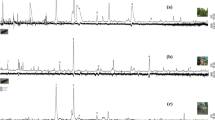Abstract
The currant clearwing Synanthedon tipuliformis (Clerck) (Sesiidae) is a worldwide pest of black currants, Ribes nigrum. This moth has been observed to feed on nectar of inflorescences of Canada thistles, Cirsium arvense (L.) Scop. This work was undertaken to identify floral compound(s) produced by Canada thistles inflorescences that mediate the response of the currant clearwing. Floral volatiles were collected during the day and analysed by coupled gas chromatography/electroantennographic detection (GC/EAD) and gas chromatography/mass spectrometry (GC/MS). Three compounds consistently elicited EAD response from moth antennae and were identified by GC/MS as phenylacetaldehyde, methyl salicylate and dimethyl salicylate. When the compounds were tested individually or in various combinations in field trapping experiments, a 3-component blend attracted the largest number of female and male currant clearwings. Subsequent field trapping experiments were conducted to determine the optimal attraction dose for the ternary blend using three loadings of 1, 10 and 100 mg loaded into a polyethylene sachet. The highest catches were in traps baited with the 100 mg loading. In all trials, males and mated females were caught in significant numbers, while very low numbers of virgin females were found in the traps. In recent years the efficacy of mating disruption against currant clearwing has been reported as declining. The new kairomone blend identified in this study can be used with the sex pheromone to provide an effective control option for this important pest.





Similar content being viewed by others
References
Andersson S, Nilsson LA, Groth I, Bergstrom G (2002) Floral scents in butterfly pollinated plants: possible convergence in chemical compositions. Bot J Linn Soc 140:129–153
Burger H, Dötterl S, Ayasse M (2010) Host-plant finding and recognition by visual and olfactory floral cues in an oligolectic bee. Funct Ecol 24:1234–1240
Connick WJ, French RC (1991) Volatiles emitted during the sexual stage of the Canada thistle rust fungus and by thistles flowers. J Agric Food Chem 39:185–188
Eby C, Gardiner MGT, Gries R, Judd GJR, Khaskin G, Gries G (2013) Phenylacetaldehyde attracts male and female apple clearwing moths, Synanthedon myopaeformis, to inflorescences of showy milkweed, Asclepias speciosa. Entomol Exp Appl 147:82–92
El-Sayed AM (2016) The pherobase: database of pheromones and semiochemicals. http://www.pherobase.com. Accessed 16 Feb 2016
El-Sayed AM, Suckling DM, Wearing CH, Byer JA (2006) Potential of mass trapping for long-term pest management and eradication of invasive species. J Econ Entomol 99:1550–1564
El-Sayed AM, Byers JA, Manning LA, Jürgens A, Mitchell VJ, Suckling DM (2008) Floral scent of Canada thistle and its potential as a generic insect attractant. J Ecol Entomol 101:720–727
El-Sayed AM, Suckling DM, Byers JA, Jang EB, Wearing CH (2009) Potential of ‘lure and kill’ for long-term pest management and eradication of invasive species. J Ecol Entomol 102:815–835
Landolt PJ, Phillips TW (1997) Host plant influences on sex pheromone behavior of phytophagous insects. Ann Rev Entomol 42:371–391
Lâstůvka Z, Lâstůvka A (2001) The sesiidae of Europe. Apollo Books, Stenstrup
Mayer DF (1997) Effects of methyl salicylate on honey bee (Apis mellifera L.) foraging. NZ J Crop and Hort 25:291–294
Omura H, Honda K (2005) Priority of color over scent during flower visitation by adult Vanessa 411 indica butterflies. Oecologia 142:588–596
Plepys D, Ibarra F, Francke W, Lofstedt C (2002) Odour-mediated nectar foraging in the silver Y moth, Autographa gamma (Lepidoptera: Noctuidae): behavioural and electrophysiological responses to floral volatiles. Oikos 99:75–82
Priesner E, Dobler G, Voerman S (1986) Synergism of positional isomers in sex attractant systems of clearwing moths (Sesiidae). Entomol Exp Appl 41:311–313
Primante C, Dötterl SA (2010) Syrphid fly uses olfactory cues to find a non-yellow flower. J Cheml Ecol 36:1207–1210
SAS Institute Inc (1998) Statview. SAS Institute Inc., Cary
Scott RR, Harrison RA (1979) The biology and life history of currant clearwing Synanthedon tipuliformis (Lepidoptera: Sesiidae) in Canterbury. NZ J Zool 6:145–163
Suckling DM (2000) Issues affecting the use of pheromones and other semiochemicals in orchards. Crop Prot 19:677–683
Suckling DM, Shaw PW (1992) Conditions that favor mating disruption of Epiphyas postvittana (Lepidoptera: Tortricidae). Env Entomol 21:949–956
Suckling DM, Gibb AR, Burnip GM, Snelling C, De Ruiter J, Langford G, El-Sayed AM (2005) Optimization of pheromone lure and trap characteristics for currant clearwing, Synanthedon tipuliformis. J Chem Ecol 31:393–407
Szöcs G, Miller LA, Thomas W, Vickers RA, Rothschild GHL, Schwartz M, Tóth M (1990) Compounds modifying male responsiveness to main female sex pheromone component of the currant borer under field conditions. J Chem Ecol 16:1289–1305
Thomas WP, Burnip GM (1991) Mating disruption of currant clearwing, Synanthedon tipuliformis. Proc. 44th N. Z. Weed Pest Control Conf, pp. 242–247
Tóth M, Landolt P, Szarukán I, Szólláth I, Vitányi I, Pénzes B, Hári K, Jósvai JK, Koczor S (2012) Female-targeted attractant containing pear ester for Synanthedon myopaeformis. Entomol Exp Appl 142:27–35
Acknowledgments
This work was supported by the New Zealand Institute for Plant and Food Research Limited with core funds from the Ministry of Business Innovation and Employment. Photo of volatile collection setup (Fig. 1) by Lee-Anne Manning.
Author information
Authors and Affiliations
Corresponding author
Additional information
Handling Editor: Michael Heethoff.
Rights and permissions
About this article
Cite this article
El-Sayed, A.M., Revell, J., Jiménez-Perez, A. et al. Identification of a floral-derived kairomone for currant clearwing, Synanthedon tipuliformis . Chemoecology 26, 187–193 (2016). https://doi.org/10.1007/s00049-016-0218-9
Received:
Accepted:
Published:
Issue Date:
DOI: https://doi.org/10.1007/s00049-016-0218-9




